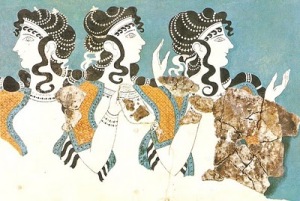The most famous work of Art Nouveau is from 1400 BC. Does that sound strange?
When I was younger, I remember the school texts praising Minoan art as colourful, harmonic, peaceful, based on vegetal motifs, and frescoes of beautiful women. Not so different from the Art Nouevau movement of the 1900’s.
The general perception of minoan society is that of a cheerful and peaceful nation: a notion that is still strong among scholars and amateurs alike. This has led some to believe that Crete could have been the much looked for Atlantis: the home of a superior, intelligent, peaceful civilization. Power was held mostly by women, often bare breasted, and life was mostly consisting in games and fishing.
Was it?
The evidence of this is, in fact, quite scarce.
First of all, the excavation at knossos has not identified any outer defence walls. This is a breakthrough, if we consider that most settlements of that time had some sort of ramparts, more or less developed. Huge walls were being built elsewhere, but not in the beautiful Crete.
And then the art of Knossos is self-explaining. No warlike gods, no men in arms… well except the Labrys.
The labrys, or double-headed axe, has been interpreted as a religious symbol of creation, sometimes assimilated with the Ankh, refusing openly to accept it as a war weapon.
But the most important point is: what do we know of minoan art?
Precious few people know that all the famous frescoes (such as the image above) were reconstructed from tiny little fragments, and purely making up the rest of the image.
Protagonists of this “invention” of archeological finds were the two “Emile Gillieron.” Yes, two, since father and son both had the same name and worked together. Their main occupation, beside painting, was making copies of well known ancient finds, such as the golden mask of Agememnon.
Copists, suspected forgers, they created most of the best-known pieces from knossos. And the palace itself, nothing but flattened ruins in 1900, was recreated by Piet de Jong. Arthur Evans, the archaeologist behind the great excavation of 1900, was well aware of that, but he and the artists worked together to give credit to Evans’ theories: that of a bright, beautiful civilization, different from the warlike people of Mycenae.
Believe it or not, the scam worked, and it created one of the most visited and appreciated archaeological sites in the world.
And now comes my question. Is it right for an archaelogist to “tamper” with the finds? To embellish a site like Evans did is surely not very scientific, but at least he recreated one of the wonders of the ancient world, and a tourist attraction without equals.


